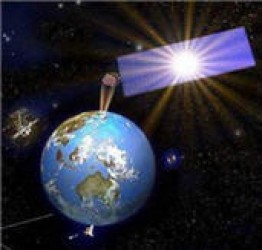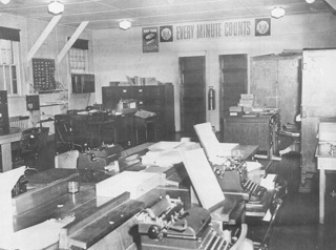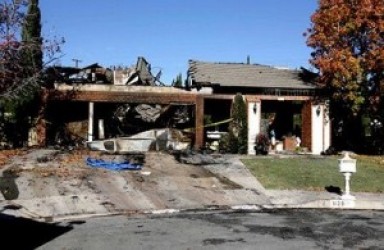Alex Constantine - November 1, 2007
 The National Security Space Office is conducting a study to determine the feasibility of space-based solar power as a source of clean energy that may be able to broadcast power to deployed forces, supplement national power grids, and other smaller applications.
The National Security Space Office is conducting a study to determine the feasibility of space-based solar power as a source of clean energy that may be able to broadcast power to deployed forces, supplement national power grids, and other smaller applications.
The study got underway on 20 April 2007 at the direction of the Director of the National Security Space Office, Major General Jim Armor, who designated his Chief of Future Concepts, Lt Col M.V. “Coyote” Smith, the director of the study.
The stimulus for this study was a briefing given to General Armor in March by Lt Col Mike “Green Hornet” Hornitschek, the ring leader of the “Space Solar Power Cabal.” The Cabal is a small group of Air Force officers and civilian scientists and engineers who have other jobs, but are true believers in space solar power and have advanced the concept inside the Washington Beltway in their spare time. Lt Col Pete “Lips” Garretson, John “The Evil Dr” Mankins, and Lt Col M.V. “Coyote” Smith are at the core of the Caballeros. The Green Hornet and Lips are designated co-leaders of the National Security Space Office study. There are over ninety volunteers serving as members of the study. They have widely diverse backgrounds but all have a passion for space, energy, commerce, public policy, or any combination thereof. ...
http://spacesolarpower.wordpress.com/the-national-security-space-office-study/
••••••••••
Technical Discussion On Power Beaming: Engineers Take Note!
Posted by Coyote on August 10th, 2007
Regarding power beaming from satellites at GEO to the Earth’s surface:
“The atmosphere has two bandwidth width windows though which it is possible to beam power between space and the surface efficiently, and outside of which atmospheric absorption will kill you: (1) a microwave window, of which the 2.45 GHz frequency (~ 12 centimeter wavelength) employed in the 1970s DoD/NASA reference SPS design is typical, and (2) a visible window extending perhaps as far into the near infrared as a micron of so in wavelength. …
The microwave window allows radio astronomers to see galaxies with their large antennae at the Earth’s surface; the second allows us to see the stars with our eyeballs. However, the wavelengths of these windows differ by a factor of 100,000, with profound implications for sizing of power beamers for space solar power applications. A major consequence of the beam spreading by diffraction related to that employed by Arthur Smith below — that is, the factor X = (transmitter aperture)x(receiver aperture)/(wavelength)(distance) must be of order one for the transmission efficiency to be of order one or greater because only then will the receiver aperture be big enough to capture the beam main lobe — is that kilometer or greater sized transmitting and receiving apertures are needed for microwave beamers to capture the main fraction of transmitted power from geostationary orbit (GEO) — the best location at least near term of a solar power satellite.
The diffraction limit on electromegnetic waves is a fundamental law of physics built into the structure of this universe. It can’t be beaten by clever engineering, and not for lack of trying (sparce arrays, etc.) The DoE/NASA reference SPS design of the 70s wound up with a 1 kilometer phased array transmitter and 10 x 13 kilometer rectenna. With these dimensions, and in order to attain a reasonable intensities inside the main lobe of the beam, you need a gigawatt sized SSP; with 5 x 10 kilometer solar panel arrays: ten gigawatts for Peter Glaser’s DoE/NASA reference design; perhaps as little as one GW for John Mankins’ Fresh Look Study cleverly designed technology. But still big. Meaning big capital investment prior to first power. In all fairness, fusion with its different physics scaling laws, also drives you for different reasons to large machines, like the 12 billion dollar International Experimental Thermonuclear Reactor (ITER) tokamak under construction in the South of France. This project isn’t even designed to produce net electric power. What it aims at is a sustained plasma burn from hot alpha particles, a “scientific milestone” far short of actual power output. Size matters, and even though it’s an interesting and relevant question why the huge ITER has its $12 billion R & D program, while SSP, intended for the same job of base load electricity production, has no money. The large size and capital investment to first power of both systems has to impact the business case. Ironically, it may be just because fusion is seen as a dream in the uncertain future, while SSP appears much more technologically mature that funding is so hard to get.
In the general soup of contemporary alternate energy discussions, diode laser beamers in geostationary orbit are a total game-changer for demonstrating space based solar power experimentally. We can build and test them now. Can we beam electricity into Iraq even as the insurgency blows up power lines? Can’t say now how much it might cost, but it’s certainly feasible in principle. My predilections are to demonstrate beaming power to some poor African village, winning the hearts and minds of our brothers and sisters in the developing world, as opposed to blasting them to bits, as some will certainly accuse developers of laser power beaming of. But the thing about any new technology is that you really can’t say at the outset where exactly it will go. What we can say with some assurance that no one has a clue how to build a small, cheap fusion reactor that would work. But we can almost certainly build an SSP with laser beaming now that would work; and build it small enough to fit into a single launch vehicle payload at a small fraction of the cost of ITER, or for that matter of FutureGen (DoE’s proposed coal-gasification to electricity and hydrogen pilot plant with CO2 sequestered), or one of DoE’s new design Gen IV fission reactors on the drawing boards. So I want to strongly agree with Jordin Kare’s comments on a the viability of an laser SSP demo expressed in his E-Mail below.
Indeed, we, my son Eric & I, have taken this idea further to the point of developing a 3-page report for DARPA: darpa-ssp-demo-exec-su_f2391.doc). But at least so far, we haven’t got very far. Perhaps it hasn’t been seen by the right people, or hasn’t become visible at the right historical moment. So I throw it into the ring once more as part of this discussion on the business case for SBSP. (We space power guys may not have any money, but we have the most acronyms: SPS, SSP and now SBSP).
Your comments, of course, are most welcome.
Cheers,
Marty Hoffert
Professor Emeritus of Physics
Andre and Bella Meyer Hall of Physics
Room 525, Mail Code 1026
4 Washington Place
New York University
New York, NY 10003-6621
http://spacesolarpower.wordpress.com/2007/08/10/technical-discussion-on-power-beaming-engineers-take-note/









